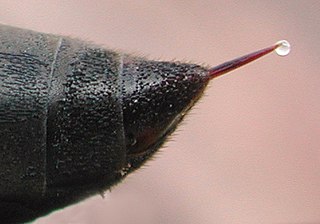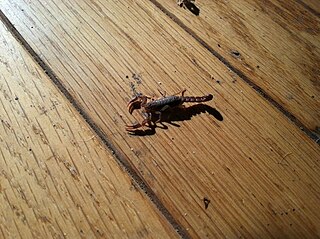Related Research Articles

Scorpions are predatory arachnids of the order Scorpiones. They have eight legs, and are easily recognized by a pair of grasping pincers and a narrow, segmented tail, often carried in a characteristic forward curve over the back and always ending with a stinger. The evolutionary history of scorpions goes back 435 million years. They mainly live in deserts but have adapted to a wide range of environmental conditions, and can be found on all continents except Antarctica. There are over 2,500 described species, with 22 extant (living) families recognized to date. Their taxonomy is being revised to account for 21st-century genomic studies.

A stinger is a sharp organ found in various animals capable of injecting venom, usually by piercing the epidermis of another animal.

The emperor scorpion, Pandinus imperator, is a species of scorpion native to rainforests and savannas in West Africa. It is one of the largest scorpions in the world and lives for 6–8 years. Its body is black, but like other scorpions it glows pastel green or blue under ultraviolet light. It is a popular species in the pet trade, and is protected by CITES.

The Arizona bark scorpion is a small light brown scorpion common to the Sonoran Desert in the southwestern United States and northwestern Mexico. An adult male can reach 8 cm in length (3.14 inches), while a female is slightly smaller, with a maximum length of 7 cm (2.75 inches).

Nepidae is a family of exclusively aquatic Heteropteran insects in the order Hemiptera. They are commonly called water scorpions for their superficial resemblance to scorpions, due to their raptorial forelegs and the presence of a long slender process at the posterior end of the abdomen, resembling a tail. There are 14 genera in the family, in two subfamilies, Nepinae and Ranatrinae. Members of the genus Ranatra, the most widespread and speciose genus, are sometimes called needle bugs or water stick insects as they are slenderer than Nepa.

Hadrurus arizonensis, the giant desert hairy scorpion, giant hairy scorpion, or Arizona Desert hairy scorpion is the largest scorpion in North America, and one of the 8–9 species of Hadrurus in the United States, attaining a length of 14 cm (5.5 in). Its large size allows it to feed easily on other scorpions and a variety of other prey, including lizards and snakes. They have also been known to take down or fight with the Giant Desert Centipedes of Arizona. This species is usually yellow with a dark top and has crab-like pincers. It gets its common names from the brown hairs that cover its body. These hairs help it to detect vibration in the soil. A similar species is the Hadrurus spadix.

Parabuthus transvaalicus is a species of venomous scorpion from semi-arid parts of southern Africa.

The striped bark scorpion is an extremely common scorpion found throughout the midsection of the United States and northern Mexico. It is perhaps the most frequently encountered scorpion in the U.S.

Paravaejovis spinigerus, commonly known as the stripe-tailed scorpion or the "devil" scorpion, is very common and widely distributed in Arizona and southwestern New Mexico. This species is one of larger members of the genus Paravaejovis, which also includes Paravaejovis confusus.

The southern grasshopper mouse or scorpion mouse is a species of predatory rodent in the family Cricetidae, native to Mexico and the states of Arizona, California, Nevada, New Mexico, and Utah in the United States. Notable for its resistance to venom, it routinely preys on the highly venomous Arizona bark scorpion.

Bursera fagaroides is a species of flowering plant in the genus Bursera known by the common names torchwood copal and fragrant bursera. It is widespread across much of Mexico from Sonora to Oaxaca, and its range extends just into Arizona in the United States, although some sources suggest that it may now be extirpated in Arizona.

Hoffmannius is a genus of scorpions in the family Vaejovidae. It comprises the following species:

Monobia quadridens is a species of solitary potter wasp found in North America. It grows to a wingspan of 18 millimetres (0.71 in), and feeds on small caterpillars and pollen. There are two generations per year, with one generation overwintering as pupae.
Vaejovis janssi is a species of scorpion endemic to the Revillagigedo Islands in Mexico.

Rhopalurus junceus, the red scorpion or blue scorpion, is an endemic species, one of 36 different types of scorpion found on Cuba and the Dominican Republic, as well as parts of Central America. It is called "blue scorpion" due to the peculiar blue tone on its tail and stinger; it is also known as "red scorpion" because it has a reddish dark body.
Vaejovis brysoni is a species of scorpions belonging to the family Vaejovidae discovered in 2013 in the Santa Catalina Mountains of southern Arizona. It was reportedly discovered in an area that overlooks the city of Tucson by Robert W. Bryson Jr., after whom the species is named. At the date of its discovery it became the tenth species of mountain scorpion known to occur in Arizona, and the second in the vorhiesi group to inhabit the specific mountain range.

Vaejovis is a genus of scorpions.

Paruroctonus is a genus of scorpions in the family Vaejovidae. There are about 8 described species in Paruroctonus.

Vaejovis carolinianus, the southern unstriped scorpion, also known as the Southern Devil Scorpion, is a species of scorpion in the family Vaejovidae.
Intrepicalcin (ViCaTx1) is a short peptide toxin found in the venom of scorpion Vaejovis intrepidus. It is one of a group of short, basic peptides called calcins, which bind to ryanodine receptors (RyRs) and thereby trigger calcium release from the sarcoplasmic reticulum.